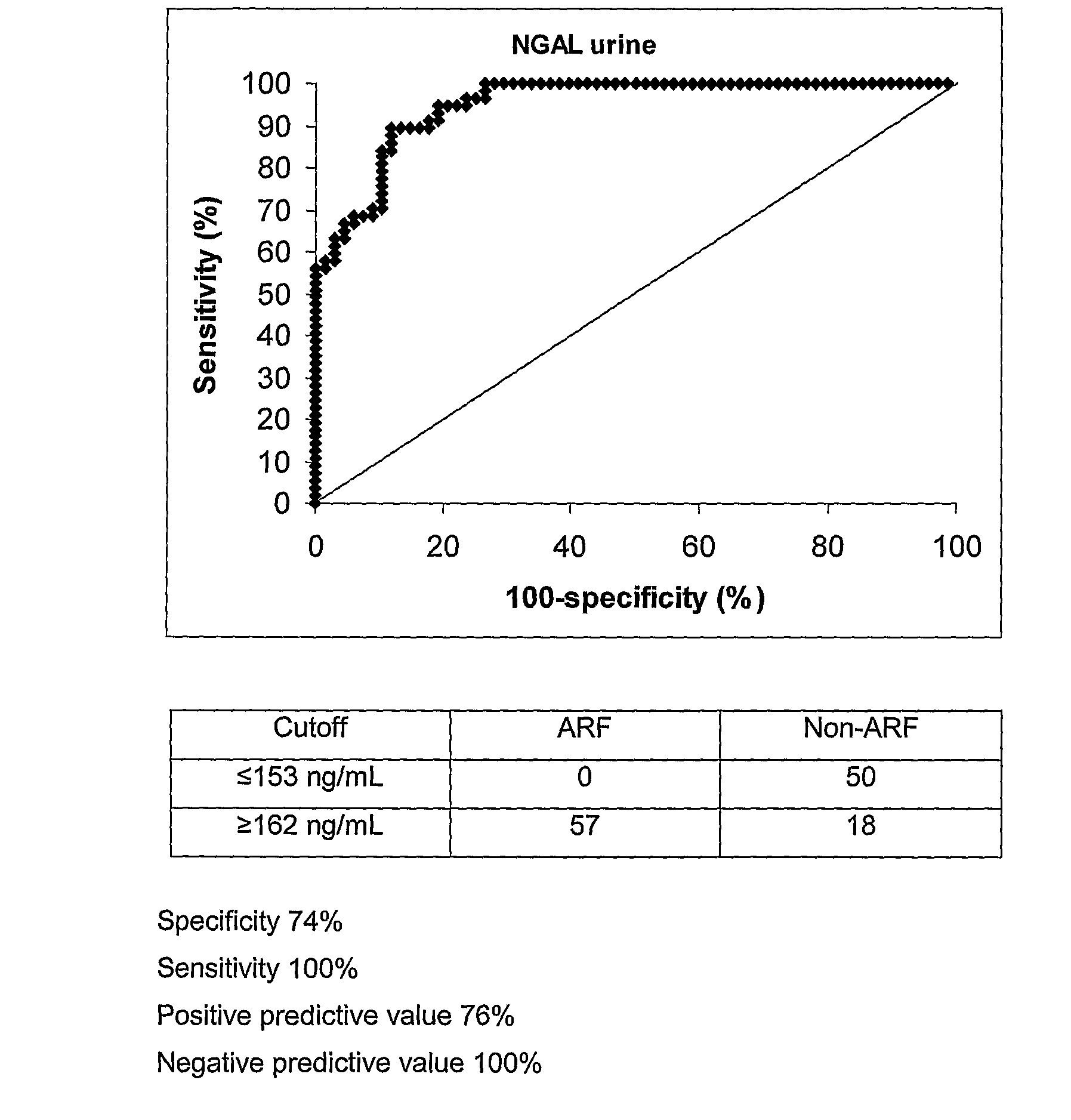Diagnostic Test to Exclude Significant Renal Injury
a technology of significant renal injury and diagnostic test, which is applied in the direction of instruments, biological material analysis, measurement devices, etc., can solve the problems of not coming into general use to diagnose early or imminent renal disorders, patient with arf not being treated, and human levels are still unknown
- Summary
- Abstract
- Description
- Claims
- Application Information
AI Technical Summary
Benefits of technology
Problems solved by technology
Method used
Image
Examples
example 1
NGAL Dipstick Test
[0029]The analytical area of a dipstick comprised of a polystyrene surface is coated with a capture antibody against human NGAL. An aliquot of the centrifuged, diluted sample is added to a solution of enzyme-labeled detection antibody against NGAL in the first tube, into which the dipstick is immersed. Complexes of enzyme-labeled detection antibody with NGAL are bound to the dipstick, which is then washed with tap water and placed in a chromogenic substrate solution in a second tube. The color developed in the substrate solution within a given time is read either by eye and compared with a chart of color intensities which indicates the concentration of NGAL in the urine sample, or in a simple colorimeter that can, for example, be programmed to indicate the NGAL concentration directly.
example 2
NGAL Lateral Flow Device
[0030]A lateral flow device comprised of a strip of porous nitrocellulose is coated near its distal end with a capture antibody against NGAL applied as a transverse band. A further transverse band of antibody against antibodies of the species from which the detection antibody is derived is placed distally to the capture antibody band and serves as a control of strip function. The proximal end of the strip contains the detection antibody against NGAL adsorbed or linked to labeled polystyrene particles or particles of dye complex. When an aliquot of the centrifuged urine sample is applied to the proximal end of the strip, the labeled particles attached to detection antibody travel along the strip by capillary attraction. When reaching the band of capture antibody, only those particles which have bound NGAL will be retained, giving rise to a detectable band. Particles reaching the control band of antibody against the detection antibody will produce a detectable ...
example 3
NGAL Minicolumn Test
[0031]A minicolumn contains a frit made of compressed polyethylene particles allowing the passage of fluid and cells. The frit is coated with capture antibody against human NGAL. The minicolumn is incorporated into a device, which by means of automated liquid handling allows the diluted sample to be applied at a fixed flow rate and volume, followed by detection antibody complexed with dye. After the passage of wash solution, the color intensity of the frit is read by light diffusion photometry. The batches of frits are pre-calibrated and the minicolumns equipped with a calibration code that can be read by the device, so that a quantitative result can be displayed by the instrument without the need for prior calibration with standards.
PUM
 Login to view more
Login to view more Abstract
Description
Claims
Application Information
 Login to view more
Login to view more - R&D Engineer
- R&D Manager
- IP Professional
- Industry Leading Data Capabilities
- Powerful AI technology
- Patent DNA Extraction
Browse by: Latest US Patents, China's latest patents, Technical Efficacy Thesaurus, Application Domain, Technology Topic.
© 2024 PatSnap. All rights reserved.Legal|Privacy policy|Modern Slavery Act Transparency Statement|Sitemap


